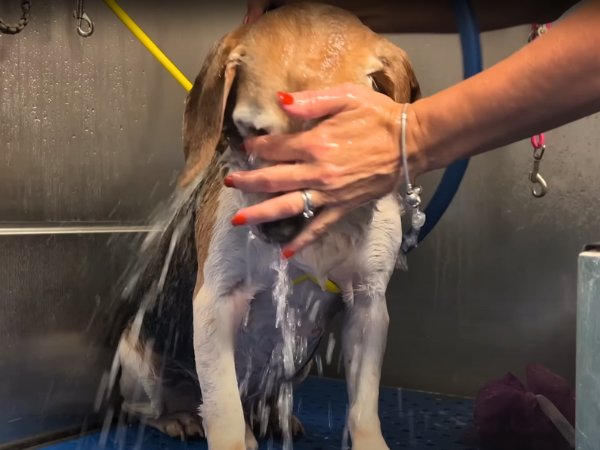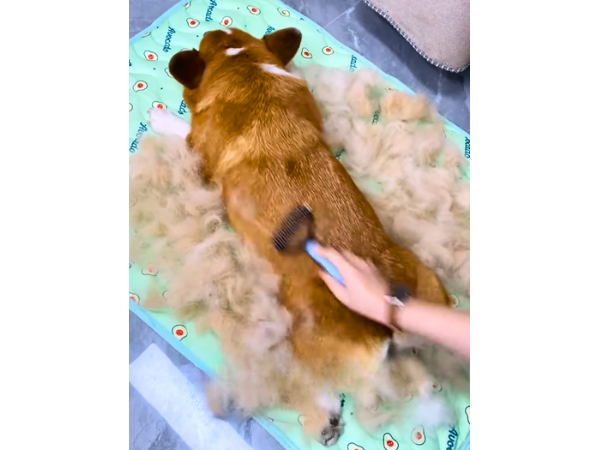Shedding season can be a messy time for dog owners, but it’s a natural part of your pup’s coat cycle.
In this guide, we’ll explore 6 essential facts about your dog’s coat, including shedding patterns, grooming tips, and strategies to keep your home.
Fact #1: Shedding Is a Natural Process
Shedding is a natural – healthy process. Dogs lose old fur to make space for new hair. This fur can be old, dead, or damaged, and removing it helps keep the coat strong and shiny.
Shedding also helps regulate a dog’s body temperature. When the weather changes, dogs shed more to adapt. In warm months, they lose thick winter fur to stay cool. In colder months, less shedding happens so the dog keeps warm.
Here are the main reasons shedding occurs:
- Removes old, dead, and damaged fur.
- Helps keep the coat clean and healthy.
- Makes room for new, healthy hair growth.
- Regulates body temperature based on the season.
Shedding is not a sign of illness. Instead, it is your dog’s way of staying healthy. Regular brushing helps remove loose fur and supports this natural process.

Fact #2: It’s All About the Seasons
Shedding season is a natural part of your dog’s life. Understanding how seasons affect your dog’s coat helps in managing shedding better. Dogs don’t just shed randomly; their coats change based on the time of year. It’s all about the seasons.
Most dogs shed heavily twice a year. These shedding cycles occur in spring and fall. The process prepares their coat for the new season’s climate. During spring, dogs lose their thick winter fur to stay cool. In fall, they shed lighter summer hair to grow a warmer coat for winter.
- Indoor dogs may shed less due to constant lighting and temperature.
- Outdoor dogs experience stronger shedding cycles as nature changes.
- Breed differences affect how much and how often dogs shed.
Shedding is triggered by the amount of daylight and the temperature outside. As days get longer in spring, dogs start shedding their winter fur. When days shorten in fall, shedding begins again to make way for the winter coat.
Fact #3: Different Coats Shed Differently
Dog coats fall mainly into two categories: single and double coats. Each type affects how much and how often your dog sheds. Knowing this helps you prepare for shedding season and choose the right grooming tools.
Double-coated breeds have two layers of fur: a soft, thick undercoat and a tougher outer coat. These dogs “blow their coat” heavily, usually twice a year. During this time, the undercoat falls out in large amounts. This process helps them stay cool in summer and warm in winter.
- Examples of double-coated breeds: Huskies, German Shepherds, Golden Retrievers.
- Shedding pattern: Heavy shedding twice a year.
- Grooming needs: Regular brushing to remove loose undercoat and prevent mats.
In contrast, single-coated breeds have only one fur layer. Their fur is often curly or silky and sheds lightly throughout the year. These dogs do not blow their coat like double-coated breeds.

Fact #4: Brushing Is Your Best Defense
The single most effective tool for managing shedding is brushing. It removes loose hair before it falls, stopping fur from spreading around your house. Regular brushing also stimulates the skin and distributes natural oils, making your dog’s coat shiny and healthy.
Choosing the right tool makes a big difference. Use a de-shedding tool or rake designed for your dog’s coat type. These tools reach under the topcoat to pull out loose hair gently.
Follow these brushing tips for best results:
- Brush your dog daily during heavy shedding.
- Start with gentle strokes to avoid skin irritation.
- Focus on areas where hair sheds most, like the neck and back.
- Use the right tool for your dog’s coat type.
- Reward your dog to make brushing a positive experience.
Brushing also helps you spot skin problems early, such as dryness or parasites. This way, you keep your dog’s coat healthy and reduce shedding stress.
Fact #5: Diet and Health Play a Huge Role
A healthy diet supports a strong – healthy coat. Without the right nutrients, your dog’s fur may become dull, brittle, or fall out more than usual. Nutrients like omega-3 and omega-6 are crucial for maintaining skin moisture and fur strength.
Dogs need specific nutrients to keep their skin hydrated and their fur thick. Fish oil and coconut oil supplements can help provide these essential fatty acids. These oils improve skin elasticity and reduce inflammation, preventing dry, flaky skin that causes more shedding.
Here are important nutrients for your dog’s coat:
- Omega-3 fatty acids: Reduce inflammation and support skin health.
- Omega-6 fatty acids: Help maintain skin barrier and moisture.
- Protein: Builds strong hair strands and supports hair growth.
- Vitamins A and E: Promote healthy skin and protect cells from damage.
Using the right supplements can boost these nutrients. For example, fish oil is rich in omega-3, while coconut oil provides healthy fats that improve coat texture.
Fact #6: A Proper Bath Can Help
Bath time is the perfect chance to get rid of loose hair. Use a quality de-shedding shampoo designed to target dead hair and reduce shedding. These shampoos help break down the oils that hold loose hair to the skin and coat.
- The warm water helps loosen dead hair from your dog’s coat.
- Careful lathering spreads the shampoo evenly and reaches the undercoat.
- Rinse thoroughly to wash away loosened hair and dirt.
After washing, drying is just as important. A powerful blow-dry removes loose undercoat that the bath has loosened. Use a dryer with adjustable heat to avoid burning your dog’s skin. This step removes hair that brushing alone can’t catch.
Always brush after a bath to prevent matting and tangles. Bathing can make fur softer and more likely to tangle. Brushing helps smooth the coat and pulls out any remaining loose hair.

